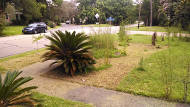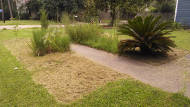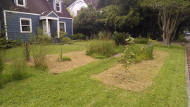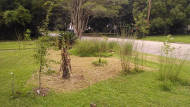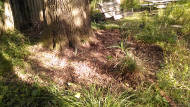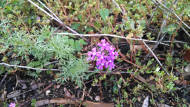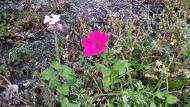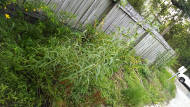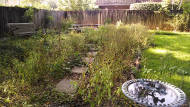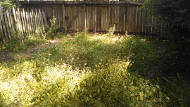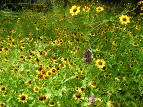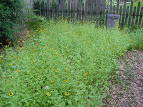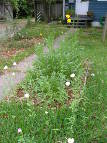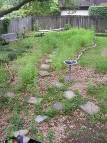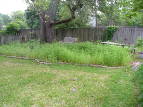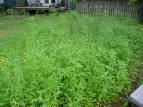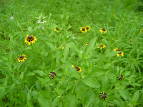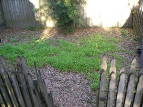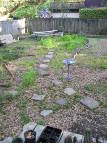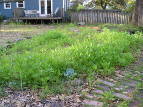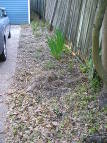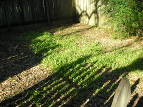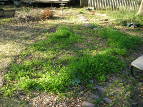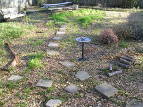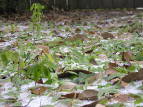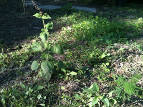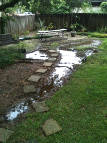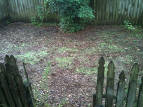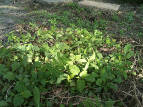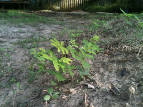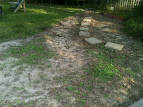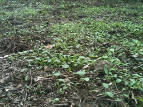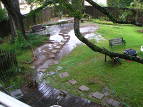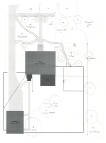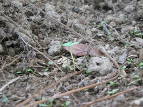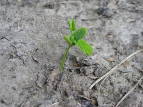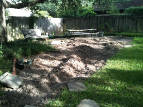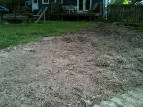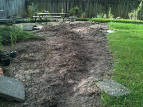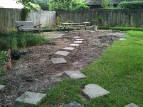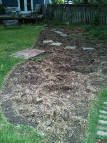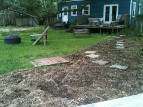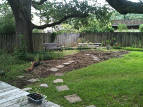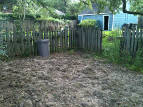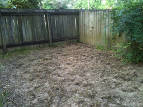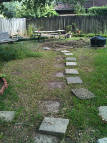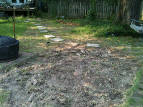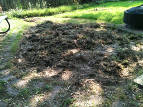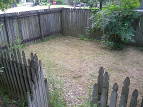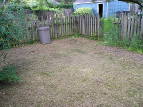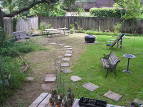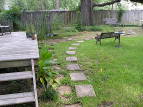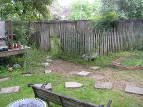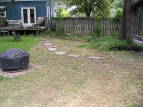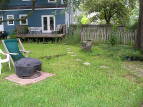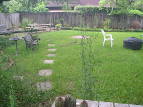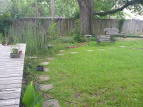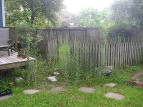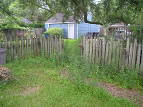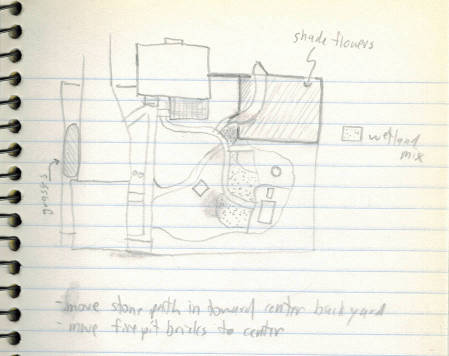Land & Plants: Yard Diary
This is a story of diversifying the species in a yard in Baton Rouge. I wanted to undo some of the damage that was done by replacing native species with exotic species. Few birds, few butterflies, constant maintenance (weeding, mowing, watering), complete disregard of the environmental uniqueness of place. I figured I could do better.
I joined the newly formed Capital Area Native Plant Society in November 2012, read some books and websites, and began experimenting. I bought native trees and shrubs but eventually realized I was missing an important piece: perennial and annual wildflowers. I also knew I would eventually have to address all that turf grass.
This page will document the transformation of my back yard into something that will bring back the wildlife. Hopefully it will work out.
2014 September 5 (Fri)
In the mail today — yes, the literal, physical, paper mail — I received a letter. It was written by my neighbor and is "Re: Landscape Concerns". I will include the key parts of it here:
I have been asked by several of the neighboring homeowners to open a dialogue with you regarding the landscape style of your yard. While I certainly respect your rights as a property owner to make certain choices with regard to your landscaping, I, along with neighbors, have become concerned that the choices you are making regarding the weeds and haphazard landscaping style, is having a negative impact on not only your property value, but the value of homes around you. Accordingly, I respectfully request that you re-consider your landscaping style (at least as it applies to the front yard and side right-of-ways) and adopt a more neat and manicured approach.
I have attached a copy of the EBR Parish ordinances regarding yard and weed standards. I am hopeful that you are open to working with you neighbors on this. Other neighbors are considering taking this matter directly to the City Parish for enforcement. However, I did not support that effort without having the opportunity to speak to you about it first.
He then included a print out of much of Title 12 Chapter 5 of the city-parish ordinances. Section 12:351 has wording that dictates that "grass and weeds do not reach a height of more than twelve (12) inches and allowed to remain in such condition for more than two (2) weeks". But I know that further on in Section 12:405, it says it is a violation if "Grass or weeds are allowed to reach a height of more than twelve (12) inches over the majority of the immovable property and allowed to remain in such condition for more than two (2) weeks." That is correct: one says "majority" and the other does not.
And there's also the problem that the municipal code does not define anywhere what a "weed" is. Grass is pretty well understood as it is a botanical term, but weed "has no botanical significance". I know what he's referencing: it's the asters I have allowed to grow in the front yard and mowed around for the fall flowering. Bees love them. My plan calls for their removal in the winter as their growth habit does not fit into my plan and I have other flowers that will eventually take over their role.
I will mow the front this weekend (with my new reel mower!), and I will attempt to talk to the neighbor to explain things more clearly. Other plans include continuing to hoe grass in the front yard and removing dead grass rhizomes. I planted a sparkleberry (Vaccinium arboreum) out there already this past Sunday, and I think it's really digging the full sun.
2014 August 3 (Sun)
On Tuesday evening as I was finally sitting down and sketching some design plans for the front yard, there was a knock on my front door. I opened the door. It was the neighbor who lives behind me. He started by asking, "Have you seen your front yard? It looks terrible." He complained about the front yard. He complained about the back alley that separates us. I let him finish and then told him I was very offended. Then I launched into telling him my plans for increasing the biodiversity of my yard through introducing native plant species. I said it was a restoration project and I'm still figuring out which species do well and where.
"But have you seen the alley?"
"Yes, everyday. At least once." This is the guy who pays a landscaper to rip up his annuals every season and plant new ones. The guy who paid his landscaper to spray herbicide on some of my alley plants. The guy who called the City to come dig up an old tree stump that had a wonderful female yaupon next to it, covered with bright red berries. When I was done, he had a very dismissive grin on his face and said, "Well, good luck with that."
As usual for me on a Saturday, I was in the back alley yesterday, going through what's growing and picking out the chamberbitter. I've now decided to pull out hairy clustervine because it's so damn invasive. I'm glad to say my neighbor saw me as he was backing out of his garage in his white Lexus and we waved. I need him on my side with this. Showing him that this is a good thing is now one of my KPIs. As I continued weeding, a woman drove down the alley, stopped, and said out the window to me, "I really like those yellow wildflowers!" (Partridge pea.)
Later on yesterday, I mowed the front yard. I didn't enjoy it. Grasshoppers big and small were fleeing for their lives. Little beetles jumped out of the grass and climbed my face. An orange and brown moth woke up groggily. Then I dropped the mower deck and went to scalping. I didn't do as much of an area as my initial plan calls for because my plan isn't really final yet. I haven't decided what I need to buy and what I've got that I will use, but I was tired of the indecision and wanted to commit to the plan in some way. And now I can look out the window and see what can be. I can go out and walk around it, looking at it from every angle. And you can too with these pictures.
2014 July 27 (Sun)
I acquired a whole lotta seeds and plants at the CANPS summer party last night.
Seeds:
- white wild indigo (Baptisia alba)
- big bluestem (Andropogon gerardii)
- coralbean (Erythrina herbacea)
- some other stuff I forget
Seedlings:
- sparkleberry (Vaccinium Arboreum)
- Dixie wood fern (Dryopteris x australis)
- cardinal flower (Lobelia cardinalis)
- Sabine coneflower (Rudbeckia scabrifolia)
- mountain mint (Pycnanthemum albescens?)
- coral honeysuckle (Lonicera sempervirens)
- virgin's bower (Clematis virginiana)
It was a great haul. I've figured out where most of it will go once they get acclimated and the weather turns cooler... except for the sparkleberry (winter huckleberry). I'm not convinced it can handle the front yard's full sun, so it may go in some partial shade.
I looked around the yard today to see where to apply my attention and labor. The answer was under the live oak where stupid monkey grass has taken over. Two years ago, I made room for two dwarf palmettos, but they've since been surrounded. I'm pleased to say I've ripped up most of the monkey grass today, though I know there are plenty of roots that will sprout again. I'll just have to pluck them until they stop sprouting, I guess. My plan is to plant some ferns around the live oak. My first fern (the Dixie whatsit) gave me the idea to finally tear into the Liriope.
The overall idea now is to focus on getting perennials established as well as getting mad amounts of native species to see what takes. So far, I haven't spent much money, but I'm afraid I'll be spending a good bit more than usual at this fall's plant sales because I want more ferns and grasses. I'll also be heading over to the Cajun Prairie tour in September to maybe acquire some seed if they let me.
2014 July 13 (Sun)
Native biodiversity is steadily increasing. The area that is doing the best is the full-sun back alley, which kind of surprised me. I thought I'd have the hardest time back there because of the blazing hot sun and dry, washed-away soil, but a lot of plants are actually starting to thrive: straggler daisy, partridge pea, lanceleaf coreopsis, purple coneflower, prairie verbena, Maximilian sunflower, black-eyed Susan, and coralbean. Some aren't particularly native to my parish, but Texas isn't that far off and I use the seeds that I've got.
I tell myself I'm going to go drive around outside city limits to get wild seeds, but I never do. So far, I've been relying on Texas seed, anything CANPS members have had available, and anything that birds and the wind introduce. Groundsel and hairy clustervine come to mind.
The Eastern Savannah Grass Mix might be growing. It's hard to say. It's going to take at least 3 years for it to get big. In the meantime, I'll do my best to keep the area short (<6 inches) and weeded — chamberbitter and crabgrass are the main culprits. I'll buy some more grass seeds to sow elsewhere. Because it takes so long, I want to start as soon as possible. My notes say I sowed some in the alley. (Hopefully, they didn't get washed away.) That means I'll only need some for the rain garden and front yard. I'll focus on little bluestem, Gulf muhly, and switchgrass. The broomsedge that came with the house is starting to spread around on its own, so no need to spend money on that one.
The rain garden and Chicken Yard are looking worn. It's because there's nothing to replace the spent coreopsis. My wish list for these areas is long: cardinal flower, American beautyberry, Indian pink, Gulf muhly, strawberry bush, Virginia sweetspire, and buttonbush. I have a little bit of inland seaoats, and it's going to take time for it to spread. A rain garden in dappled shade is slightly difficult to plant for, but I think it can be done.
As far as the insects go, I'm seeing more bees and butterflies now. Not crazy numbers of them. Just a modest increase. Bumblebees love the partridge pea.
2014 May 16 (Fri)
The rain garden is now fully covered with coreopsis. Some clasping coneflowers are coming in along with some horsemint. The tallest plants are roughly 5' tall. It's about time to finally cut the path to the back swing since it's pretty overgrown.
With all these flowers, I would have expected tons of bees and butterflies. The number of native bees has increased lately, but I'm wondering if the word will ever get out that this is the flower party.
The Chicken Yard flowers are relatively stunted, but almost in a kinder way since they don't look so overgrown. The shade is keeping them smaller, but they are still flowering. Even though the seed mixes were different, the two areas currently have the same flowers. I'm guessing it's the ones that go to flower in only 8 months after sowing. As things age, I assume it'll work itself out and flowers will be more mature and also grow better in some places over others.
2014 April 26 (Sat)
The rain garden has filled out nicely, but I'm noticing a particular lack of something: grasses. I suppose one of my initial-phase goals was to just get some diverse species established, which is why I haven't trimmed any plants from growing between the stepping stones. (They're blocking the last few on the way to the back bench.) Now that they're established and apparently doing well — the tallest plants are 4' tall — I'm waiting for the flowers and resulting seeds. At that time, I think I'll start discouraging some growth.
I really have no idea where this is going. I haven't even seen a year of blooms yet, so I don't know what it's going to do out there. I actually haven't even seen many insects except a few crickets and tiny damselflies. I'm still waiting on those butterflies. I just sowed some of the Eastern Savannah Grass Mix this past week by the driveway — see my original plan — but it hasn't rained yet so nothing has sprouted. I think what I'm doing is little tests here and there: the wildflowers are on one side and the grasses are segregated over some place else. I expect I'll eventually start blending the two. Maybe that could be a goal from the front yard, which I will plan over the next several months and start working on in late summer.
The Chicken Yard, in case you're wondering, is doing ok. No blooms yet, really. I think it's growing more slowly because it's in dappled shade. I planted a trillium and a mayapple recently.
I hear the voice in the back of my head: "that rain garden's nice and all, but it's kinda leggy and messy." I think what's still missing is maturity, forms, and shapes. I've planted a Virginia sweetspire, buttonbush, and inland seaoats in three places, hoping that they can begin growing and creating visual anchors. No idea if those beautyberry and Turk's cap seeds will take, but I'll keep trying. Or maybe I'll just buy some older plants.
2014 March 31 (Mon)
Amazing what a little warmer weather and rain will do for wildflowers in the spring. It's only been two weeks, and I can definitely see a huge difference.
The first picture is the Chicken Yard. Some areas, the flowers took to while other areas are rather sparse. I'm not sure what the difference is exactly, but I'm guessing it has to do with lighting, heat, and height (as in where water did not pool).
The second and third pictures are the rain garden. Plant size is hard to make out, but they are big and lush with lots of flower buds. Two flowers are visible if you know where to look. The second picture shows the brand new mound for more flowers (bottom right). The mound currently looks remarkably like a grave. I'm considering putting a tombstone there.
The fourth picture is where the "grassland" will be. I finished the first pass of hoeing over this area, leaving a bottlebrush and some irises. At some point, I'll shake out the St. Augustine roots and rhizomes like I did with the other areas. One concern I have here is how close cars can park to it. As a passenger, I open the door all the time and step out into the grass. When it was turfgrass, that was fine. I don't know yet how to handle native grasses here. Maybe an arc of bricks or something.
2014 March 18 (Tue)
The days have been getting warmer and sunnier. The rate of growth in the rain garden has increased lately, though the plants have generally been growing all winter too. The Chicken Yard sprouts have been growing much more slowly, but I'm not too worried. I can spot some flower buds starting to form, and I'm really looking forward to seeing them open so I can figure out what they even are. Looks like a bunch of Rudbeckia to me.
Since I had a lot of extra seeds from the Wetland Fringe mix, I hoed a little area between the trail and the deck, made a mound, and scattered seed around. Nothing to see yet, so I haven't taken a picture. All of these areas are under a giant live oak. Now that I'm not raking any more, its leaves are covering all that was bare dirt. This is rather good, but it makes it more difficult (I assume) to sow new seeds.
2014 January 29 (Wed)
It snowed yesterday and last Friday. Well, it was icy sleet balls. The exotic tropicals and citrus took a beating, but the natives did just fine. This picture shows the Chicken Yard and the layer of ice that's still out there. I read that planting as I did in the fall would let the plants grow roots throughout the winter, but I didn't expect them to grow much above ground. I'm seeing new growth even though it's been pretty cold. One yellow flower even grew a month or so ago.
2013 November 29 (Fri)
Growing natives requires patience. I would say moreso than gardening with exotics. This is because of the naysayers as well as personal inexperience with natives. I fluctuate between resolve and doubt when I go out and look at the rain garden, often in the same sitting. One minute, I see great potential and growth. The next, it's just a bare dirt ditch with weeds.
Well, I just read some good advice to keep going: "Most perennial prairie flowers and grasses will not begin to flower until their third or fourth full growing season. Patience is a virtue when establishing a prairie!... Although your seeding may appear to be a bit of a weed patch in the first year or two, by the third year numerous flowers and grasses should begin blooming.... Perennial prairie plants devote most of their efforts in the first few years to developing their famous root systems. They will not be readily apparent in the first year, with little visible above-ground growth.... The deep roots of the prairie flowers and grasses give them long-term staying power that allows them to squeeze out annual and biennial weeds, and to return year after year for decades."
I'm not exactly going for a prairie in the backyard (maybe), but I'd say this holds for rain gardens, too. "Just wait for next year," I tell people. And myself.
2013 October 20 (Sun)
The scarlet sage are starting to flower. There are also a bunch of bundleflowers. I can't really identify much else right now, but this I know: the seeds did not take equally well to all parts of the rain garden. The places that are doing better are higher and sunnier. The low-lying areas and shady areas are very sparse. It's hard to tell which variable has the greater effect, but I think this will be a much longer term project than I had thought. It's going to take a while to figure out what will do well.
Since the rain garden is under a live oak, there will be substantial leaf drop in the spring. So far, this sounds like a good thing since I don't have any mulch.
2013 October 6 (Sun)
At the Hilltop Arboretum PlantFest, I bought two tulip trees and one American hornbeam for the front yard. For the back, I bought a maypop, inland seaoats, and a buttonbush. I only planted the three trees today since I already had places for them. The others, I'm not sure where they'll go yet. I'll probably put the maypop up against the fence somewhere. The other two will be in the rain garden.
PlantFest didn't have the Shumard oak or hophornbeam that I wanted, so that may wait until the Baton Rouge Green Tree-for-All in a month.
A couple days ago, I harvested some beautyberry and Turk's cap seeds and tossed them in the rain garden. They may not grow, but I thought it couldn't hurt.
2013 October 1 (Tue)
Another storm, more proof that it's a rain garden I built. I've started listing plants that would do well in all that water but still be ok when it's dry. My list has goldenrod, lyreleaf sage*, inland seaoats, buttonbush*, spiderwort, American beautyberry*, and Turk's cap. Depending on the price and availability, I might buy the ones with asterisks from the Hilltop Arboretum PlantFest on Saturday. Or I may just go with seeds and buy only trees (for my front yard plan).
2013 September 29 (Sun)
The rain last weekend helped out some of the sprouts while killing others. In the first three pictures, you can see that those in the "highlands" survived while those in the "lowlands" perished. This has made me rethink my haphazard plan. All the low parts where water collects should be a a different sort of plant: those that can be flooded. I initially thought of horsetail (Equisetum hyemale), but it is said to be very aggressive. I still haven't figured it out.
The fourth picture is the Chicken Yard.
2013 September 22 (Sun)
It occurred to me this evening that I don't have a "wetland fringe". I have a rain garden. I may have been too eager to have a one-stop solution (seed mix) that I didn't really consider that I'd need to do more research on this as well. What happens in the area in question is that it's mostly dry, but sometimes it rains a lot. The majority of the backyard drains to it during heavy rain, and it's now responsible for retaining the water and processing it in some way. I'm two weeks away from the Hilltop Arboretum Fall PlantFest, so I've got some research to do to figure out what native plants are adapted to dealing with "mostly shaded (except for one sunny part) and dry but sometimes flooded for 24 hours" conditions.
2013 September 21 (Sat)
I'm a little worried now. It's been raining all night, and the backyard has standing water in my "wetland" area. I worry that the little sprouts will die in the flood. I'm really glad I have extra seeds now, but it wouldn't be too big of a deal to order another pack (17$). But really, I would hope that these species have evolved to handle this sort of thing.
2013 September 17 (Tue)
I'm now fairly certain that previous picture is of a partridge pea. They've gotten bigger and look a lot like the one that I have growing in the back alley. There are also so many of them that I figure they can't possibly be silk trees.
I've been watering about every other day when it hasn't rained. I've wondered if I should water the area that gets direct sun more often. It doesn't look like anywhere near as many seeds have sprouted in it. Not sure what that's about. It's a good thing I have some extra seeds from the packet.
Oh, I've also started drawing plans for the front yard. It's a hot, grassy wasteland in the summer. I've picked out some trees I want to buy at this fall's plant sales. Since they take a while to grow, I'll need to also draw up plans for wildflowers and maybe grasses. As much as I don't like the thought, it will probably only be next year when I can implement any plan I come up with. They say to sow wildflowers in the fall, but maybe I'll force them to grow in the spring. We'll see. Or maybe I'll just sow some grass since that is sown in the spring. You never know.
2013 September 8 (Sun)
It rained three times this past week. I also watered before I knew the rain was coming. Lots of seeds have sprouted. I imagine most of them are the ones I sprouted, but I can't be sure until they get bigger. I think that second picture is of an Illinois bundleflower, which is exciting. I think I may have mistakenly plucked these up in the past because I thought they were silk trees.
2013 September 1 (Sun)
I sowed the Wetland Fringe Mix today, but it left me unsure about how well "wetland" plants will do right there. I guess it hasn't rained in a long time, but the dirt is super dry. Maybe it won't be a big deal once everything is established and their roots have grown down. I only used maybe 2/3 of the pack. Native American Seed lists this size covering 500 square feet. I figured my area is around 200 square feet. I don't have anywhere else in mind to sow this stuff, so I think I'll wait a couple weeks and sow the rest in the same area, just to make sure it takes.
As for whether to water or wait for rain, I don't know. I think I'll make the call tomorrow once I see the forecast. Right now, I'm leaning toward dragging the hose out there and watering. Thankfully it only takes a short, light watering while it's still seed.
2013 August 31 (Sat)
I did it: I sowed the Shade-Friendly Wildflower Mix in the chicken yard. I reread the Native American Seed webpage on how to do it and when the best time is. They said August to November, the sooner the better. So since it's almost September, surely now would be perfect.
I poured seed in my hand and cast it out like I was feeding chickens. I went through the entire bag, which they said would cover 500 square feet. The chicken yard is 400 square feet, so I should be ok. I lightly waved a branch over the ground to move dirt around a bit, then I walked over everything to press seed in. Now I wait for rain. If I get impatient at the lack of rain, I'll consider watering, but for now I'm going with natural sky water.
In the wetland fringe area, I did some more touch-ups: pulling some grass from around the live oak roots. I think I'll sow that area tomorrow or Monday. I'll see how I feel and if I want to commit to the current landforming that I did last weekend.
2013 August 25 (Sun)
This weekend, I wanted to just go through everything again and pull out large clumps of grass roots. As I was doing it, I remembered I had wanted to reform the ground a bit so that the very back brick area doesn't get swamped with water whenever it rains a lot. So I started digging a slight depression and a levee of sorts. It's hard to tell which way the water will drain, but it's looking kinda cool now. I made a little ridge and put the stepping stones on it. I guess I'll wait for the dirt to settle a bit. Hopefully, it'll rain at some point, too. Then I might just be ready for sowing next month. I haven't decided exactly when I want to. Perhaps mid-month.
Something I should mention: I discovered thick clematis roots just underneath the surface in the chicken yard. It's obviously been growing there a while. The thickest root was maybe 0.75". I don't think I was able to hoe it all up, so I'm sure I'll get that invasive vine sprouting up again at some point.
2013 August 18 (Sun)
I finished hoeing all the areas I was planning to on Friday. Today, I moved the bricks from the firepit area and then went back and re-hoed everything to mix up more of the roots to try to dry them out. I'm wondering how effective this method is going to be. I know some roots will remain viable. Then there are the dormant seeds hanging around.
2013 August 4 (Sun)
My hoe came in earlier this week. Today, I got to use it. I hoed the chicken yard and a good bit of the future wetland. This was not easy in 95°F, high-humidity weather. The hoe was super sharp and was working out really well, but I hit some gravel or something at various points. The edge now has some dents. I'll need to buy a file.
Overall, the roots were very shallow. I guess that was St. Augustine. The monkey grass, though, was more difficult. Then there was some miscellaneous, thin grass that wasn't too happy to be hacked up. I decided to come back to it another day. I expect a lot of the grass to continue growing because I didn't remove any of it. I'll see how that goes. I'll probably hoe a couple more times before I sow any seeds.
2013 July 28 (Sun)
I decided to scalp the future wetland fringe area again. Some of the grass was starting to shoot up again.
In other news, I have received my three packages of seed from Native American Seed! I'm excited to see the day that I can sow it all. Before I can get there, I still had to buy a hoe, so I did that yesterday. I got a Rogue hoe, again from NAS. It turned out to be cheaper from them than the Rogue company themselves. Before I ordered it, I went to a couple local hardware stores and was not impressed with their hoe selection. I decided to suck it up and spend a little more for something that looks quality.
2013 July 20 (Sat)
Today was the day to scalp some turf grass in preparation of my hoeing next month (or so), which I'll be doing instead of tilling. I dropped the mower and went at it. I went slowly to give grasshoppers a chance to hop away. Then I moved the stepping stones to what may or may not be their final locations. I just placed them on top of the ground without digging. I think I'll level a couple of them later on when I decide it's good.
2013 July 14 (Sun)
I forgot to take one from this angle.
2013 July 7 (Sun)
I figured I should take some "before" pictures. Here they are.
2013 July 6 (Sat)
I printed out a better scaled drawing of the yard and copied my previous plan onto it.
Looking a lot better with all those trees. I'll be moving some trees in the winter to better locations. The chicken yard will get a red buckeye or two. The grassland by the driveway will lose a red buckeye and a bottlebrush. Not sure where the latter non-native will go yet.
2013 July 4 (Thu)
It was time to move beyond ideas. I whipped out a notebook and made a quick sketch of what I've been considering for a while now.
I found some mixed seed packets from Native American Seed. I want to plant some Eastern Savannah Grass Mix by the driveway, some Shade-Friendly Wildflower Mix in the "chicken yard" (where there was a chicken coop before we moved in), and Wetland Fringe Mix in a low part of the yard where water collects after it rains.
I want to move the deck-to-back-corner walkway, bringing it closer to the middle of the yard. I also want to create a new path that crosses the yard in the other direction from the garage to the chicken yard entrance. The firepit will be moved to this new path, taking it out of the shallow where the "wetland" area will be.
